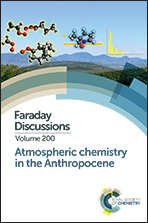Clustering approaches to improve the performance of low cost air pollution sensors
Abstract
Low cost air pollution sensors have substantial potential for atmospheric research and for the applied control of pollution in the urban environment, including more localized warnings to the public. The current generation of single-chemical gas sensors experience degrees of interference from other co-pollutants and have sensitivity to environmental factors such as temperature, wind speed and supply voltage. There are uncertainties introduced also because of sensor-to-sensor response variability, although this is less well reported. The sensitivity of Metal Oxide Sensors (MOS) to volatile organic compounds (VOCs) changed with relative humidity (RH) by up to a factor of five over the range of 19–90% RH and with an uncertainty in the correction of a factor of two at any given RH. The short-term (second to minute) stabilities of MOS and electrochemical CO sensor responses were reasonable. During more extended use, inter-sensor quantitative comparability was degraded due to unpredictable variability in individual sensor responses (to either measurand or interference or both) drifting over timescales of several hours to days. For timescales longer than a week identical sensors showed slow, often downwards, drifts in their responses which diverged across six CO sensors by up to 30% after two weeks. The measurement derived from the median sensor within clusters of 6, 8 and up to 21 sensors was evaluated against individual sensor performance and external reference values. The clustered approach maintained the cost competitiveness of a sensor device, but the median concentration from the ensemble of sensor signals largely eliminated the randomised hour-to-day response drift seen in individual sensors and excluded the effects of small numbers of poorly performing sensors that drifted significantly over longer time periods. The results demonstrate that for individual sensors to be optimally comparable to one another, and to reference instruments, they would likely require frequent calibration. The use of a cluster median value eliminates unpredictable medium term response changes, and other longer term outlier behaviours, extending the likely period needed between calibration and making a linear interpolation between calibrations more appropriate. Through the use of sensor clusters rather than individual sensors, existing low cost technologies could deliver significantly improved quality of observations.
- This article is part of the themed collection: Atmospheric chemistry in the Anthropocene


 Please wait while we load your content...
Please wait while we load your content...